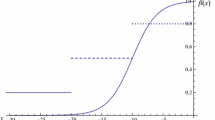Abstract
In this paper we study an inventory model with backorders where the purchase unit price depends on the ordered quantity. This situation appears in practice when a salesperson offers a fixed compensation to a client for not losing the sale and there are quantity discounts. The optimal policy is obtained through a sequential optimization procedure in two stages that relies on a quadratic function (first stage) and on the objective function of the classical EOQ model (second stage). An algorithm is developed for the model and some extensions are commented.
Similar content being viewed by others
References
Aucamp D.C. (1982). Nonlinear Freight Costs in the EOQ Problem.European Journal of Operational Research 9, 61–63.
Baumol W.J. and Vinod H.D. (1970). An inventory theoretic model of freight transport demand.Management Science 16, 413–421.
Benton W.C. (1991). Quantity discount decisions under conditions of multiple items, multiple suppliers and resource limitations.International Journal of Production Research 29, 1953–1961.
Chikán A. (1990).Inventory Models. Kluwer Academic Publishers.
Fazel F., Fischer K.P. and Gilbert E.W. (1998). JIT purchasing vs. EOQ with a price discount: An analytical comparation of inventory costs.International Journal of Production Economics 54, 101–109.
Federguen A. and Lee C.Y. (1990). The Dynamic Lot Size Model with Quantity Discount.Naval Research Logistics 37, 707–713.
Güder F. and Zydiak J.L. (2000). Fixed cycle ordering policies for capacitated multiple item inventory systems with quantity discounts.Computers and Industrial Engineering 38, 67–77.
Hadley G. and Whitin T.M. (1963).Analysis of Inventory Systems. Prentice Hall.
Harris F.W. (1913). How Many Parts To Make at Once.Factory, The Magazine of Management 10, 135–136. Reprinted in:Operations Research 38, 947–950.
Hax A.C. and Candea D. (1984).Production and Inventory Management. Prentice Hall.
Hwang H., Moon D.H. and Shinn S.W. (1990). An EOQ Model with Quantity Discounts for Both Purchasing Price and Freight Cost.Computers and Operations Research 17, 73–78.
Jucker J.V. and Rosenblatt M.J. (1985). Single-Period Inventory Models with Demand Uncertainty and Quantity Discounts: Behavioral Implications and a New Solution Procedure.Naval Research Logistics Quaterly 32, 537–550.
Knowles T.W. (1988). All-Units Discounts for Standard Container Sizes.Decision Sciences 19, 848–857.
Lee H.L. and Nahmias S. (1993). Single-Product, Single-Location Models. In: Graves S.C., Rinnoy Kan A.H.G. and Zipkin P.H. (eds.),Handbooks in Operations Research and Management Science, 4: Logistics of Production and Inventory. Norh-Holland, 3–54.
Love F.S. (1979).Inventory Control. McGraw Hill.
Matsuyama K. (2001). The EOQ-Models modified by introducing discount of purchase price or increase of setup cost.International Journal of Production Economics 73, 83–99.
Naddor E. (1966).Inventory Systems. John Wiley.
Rubin P.A. and Benton W.C. (2003). Evaluating jointly contrained order quantity complexities for incremental discounts.European Journal of Operational Research 149, 557–570.
San José L.A. and García-Laguna J. (2002). A lot size model with loss of sales and all-units discounts. Preprint.
Silver E.A. and Peterson R. (1985).Decision Systems for Inventory Management and Production Planning. John Wiley.
Tersine R.J., Larson P.D. and Barman S. (1989). An Economic Inventory/Transport Model with Freight Rate Discounts.Logistics and Transportation Review 25, 291–306.
Tersine R.J. and Barman S. (1991). Lot Size Optimization with Quantity and Freight Rate Discounts.The Logistics and Transportation Review 27, 319–332.
Tersine R.J. and Barman S. (1994). Optimal Lot Sizes for Unit and Shipping Discounts Situations.IIE Transactions 26, 97–101.
Tersine R.J. (1994).Principles of Inventory and Materials Management (fourth edition). Prentice-Hall.
Tersine R.J., Barman S. and Toelle R.A. (1995). Composite Lot Sizing with Quantity and Freight Discounts.Computers and Industrial Engineering 28, 107–122.
Wee H.M. (1999). Deteriorating inventory model with quantity discount, pricing and partial backordenring.International Journal of Production Economics 59, 511–518.
Wilson R.H. (1934). A Scientific Routine for Stock Control.Harvard Business Review, 13, 116–128.
Author information
Authors and Affiliations
Rights and permissions
About this article
Cite this article
San José, L.A., García-Laguna, J. An EOQ model with backorders and all-units discounts. Top 11, 253–274 (2003). https://doi.org/10.1007/BF02579044
Received:
Accepted:
Issue Date:
DOI: https://doi.org/10.1007/BF02579044




